On a recent hike up Wet Beaver Creek we were lucky to find many agave plants in bloom. This particular plant had an insect browsing upon it.

Farther upstream we were treated to some dazzling dragon flies.
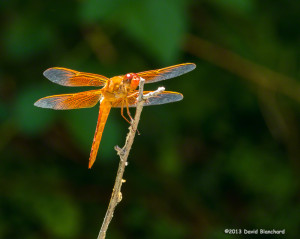
A great day. And we did some swimming, too!

On a recent hike up Wet Beaver Creek we were lucky to find many agave plants in bloom. This particular plant had an insect browsing upon it.

Farther upstream we were treated to some dazzling dragon flies.

A great day. And we did some swimming, too!

A recent hike in the Superstition Mountains east of Phoenix resulted in these two interesting images.
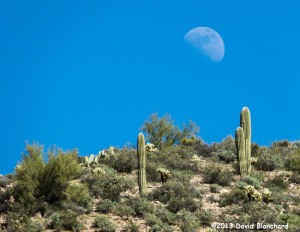
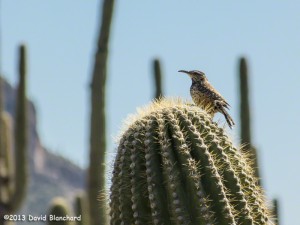
There are no pictures from the day before — I forgot to load a battery into the camera. It happens.
It’s been cold around these parts lately. How cold? Well, we’ve seen -24ºF in Bellemont, -19ºF in Tusayan, and -9ºF in Flagstaff. These are all northern Arizona communities that are used to the cold — but not for this many days in a row. This is the coldest 5-day period in Flagstaff in over three decades.
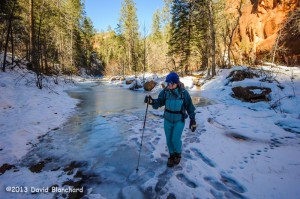
There are some benefits. With prolonged cold some of the streams in the canyons will freeze. With this in mind, we took a hike up West Fork Oak Creek. The trail was snow packed and icy. Wisely, we all had foot traction gear including instep crampons and microspikes.
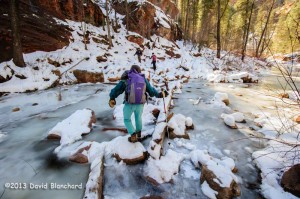
The trail crosses the creek numerous times and the first few crossings were tricky but doable. That is, the logs and/or stepping stones were ice covered but sure footing could be found using care and caution.

One of stream crossings, though, stymied us. For whatever reasons, the water and ice level had increased substantially in this location so that all the stepping stones were well under water and ice. And the flow of water had become concentrated along one side of the channel so that the ice was eroded. After studying it for awhile, we reluctantly agreed that the risk of crashing through the ice was too great. We turned back.
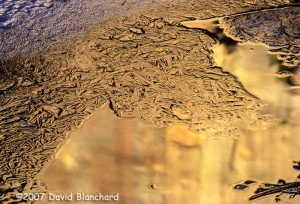
In previous years we had easily moved through this crossing and many others farther upstream including the “subway” passage. We had hoped to make it this far and, possibly, even farther upstream. It wasn’t to be.

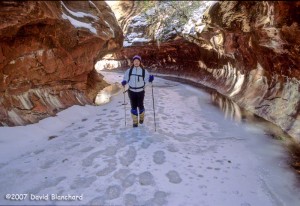
Still, it’s never a bad day when you are out hiking with no one else around except your friends in an environment not often experienced by most.
Edit: 01 Feb 2013 – fixed typos.
Three of us recently did a day hike in Buckskin Gulch. This is a well-known slot canyon on the Utah side of the Utah/Arizona border. The canyon is about 13 miles long making it one of the longest slot canyons in the southwest — and possibly the world.
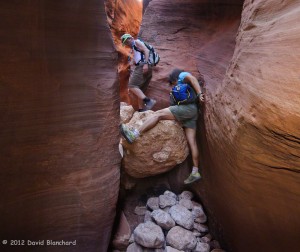
In normal years rainfall during the summer, fall, and winter leaves ankle- to knee-deep pools of cold water in the canyon. Hiking through here under these conditions is tricky since the pools are often scoured by the rushing water which may result in one side being deep and the other shallow as the sand or rocks build up. With muddy water it is impossible to see under the surface of the water and a walking pole is used to probe carefully before placing each step. A mis-step can result in going from knee-deep water to chest-deep water in one quick step!
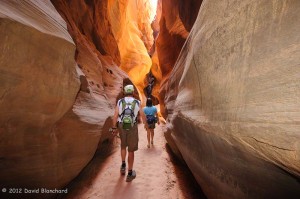
Some years, however, the fall and winter months are dry and the canyon floor is dry in the spring. That was the case this year. After a wet fall, a dry winter and spring followed and this allowed the canyon floor to be water free — at least in the first few miles that we traveled.
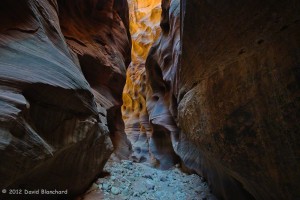
The first time we did this hike (2004) it was dry and we mistakenly assumed this was normal. Returning to hike in 2005, 2006, and 2007, we were greeted each time with water. So it was a pleasant surprise to return after a few years absence and find it dry.
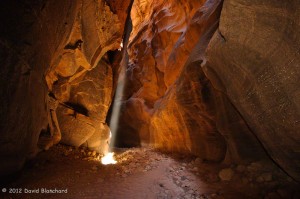
What was less pleasant was seeing how visitors to this amazing place have left graffiti along the canyon walls. There was no graffiti the first three times we visited and only one defacement the last time. This time there was graffiti in many locations in the first few miles of the canyon. It is truly saddening that people would do such a thing in a beautiful place.
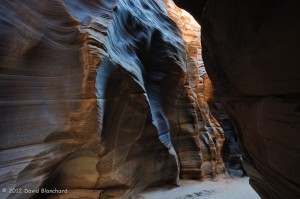
Still, we had a great time walking a few miles down canyon, eating our lunch in the cool and quiet narrows of the slot, and enjoying our brief visit to this remarkable place.
Wet Beaver Creek is a popular destination for hikers — especially in the hotter months. Along the stream are many trees providing shade and cooler temperatures. But the biggest draw is the swimming hole locally known as “The Crack” located about three and one-half miles upstream from the trail head. On a hot and sunny weekend there might be a few dozen visitors swimming and relaxing by the stream. Even on a cold weekday you might find visitors because even though it is too cold to swim it is still magnificent to see. (Well, maybe not too cold. I’ve seen trail runners jump in during the winter!)

But go beyond The Crack and the crowds thin out quickly. There is no trail other than a faint footpath that wanders from one bank to the other. There are sections that require wading in the water. And then there are the required swims (“aqua-hiking”) in which the canyon sides close in and the water deepens.
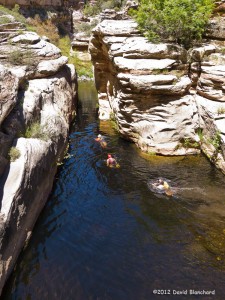
These are best done in the hottest months otherwise the hypothermia factor must be considered. Finally, these are not easy miles so it takes far longer to travel than one might anticipate.